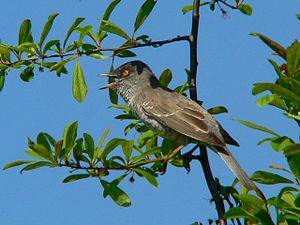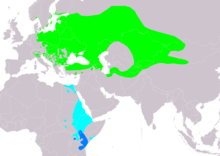Sparrowhawk Warbler
| Sparrowhawk Warbler | ||||||||||||
|---|---|---|---|---|---|---|---|---|---|---|---|---|

Sparrowhawk Warbler ( Sylvia nisoria ) |
||||||||||||
| Systematics | ||||||||||||
|
||||||||||||
| Scientific name | ||||||||||||
| Sylvia nisoria | ||||||||||||
| ( Bechstein , 1792) |
The Sperbergrasmücke ( Sylvia nisoria ) is a singing bird from the genus of Whitethroats (Sylvia). The barber warbler is next to the Orpheus warbler the largest Central European species of its genus. In Eastern Central Europe it is a widespread, regionally frequent breeding and summer bird. In western Central Europe it occurs only locally and sometimes irregularly as a breeding bird.
description
The barber warbler is 15.5 to 17 centimeters long and has a wingspan of 26 to 29 centimeters. The weight is 28 to 32 grams. The top is gray-brown and the chest is sparse , i.e. H. dark gray with lighter, thin horizontal stripes. The beak is relatively pointed and white-gray on the underside. The yellow iris and the shape of the tail are reminiscent of a (female) sparrowhawk . The legs are light brown. Males and females are almost identical in color.
The sexes are in appearance to the color of the iris in adult dress in female is brown yellow bright yellow in males, and the color of the head and back, which are gray brown in males dark gray and females are different.
The young birds are gray-brown on the top and beige-gray on the underside. They are only clobbered on the lower stomach and rump . The cover plumage of the wings has light colored edges.
The sparrowhawk warbler , especially the male with a breeding area , is easily recognizable by the singing flight of medium-high trees, with the wings clapping together like the wood pigeon .
distribution
The sparrowhawk is a breeding bird in the central Palearctic. Their breeding area extends from the east of Scandinavia, the east of Central Europe and the northeast of Italy to the Urals and in a southerly direction to the Mongolian Altai. The northern limit of distribution in the European part of Russia is about 60 degrees north latitude, in southwest Finland about 61 ° N.
In Central Europe, their main distribution is in the eastern lowlands with individual foothills to the west. However, these are not settled permanently. There are isolated small breeding populations in Switzerland, but at the beginning of the 21st century the breeding population there was estimated to be no more than 10 breeding pairs.
The barber warbler is a long-distance migrant . From May to September it stays for breeding in Central Europe , the winter quarters are in tropical Africa . It is a migratory bird on the eastern route, i.e. H. the Mediterranean is only flown over at the Bosporus , if at all . The main passage area is the Middle East .
habitat
The barber warbler lives in high bushes, with z. B. sloe , hawthorn or dog rose , individual trees in open terrain, as well as in clearings with numerous bushes in open forest. The habitat is often shared with the red-backed shrike.
voice
The very typical call is loud rattling "trrrrr't't'-t" and is reminiscent of screeching house sparrows . Mostly it follows stanzas of the song. The warning call is hoarse and muffled "Tschähr". The song is similar to that of the garden warbler , but always harder, rougher and a little higher. It contains more whistles woven into it.
food
The barnacle warbler feeds on spiders , mollusks, berries , insects and their larvae .
Reproduction

At the age of one year, the barnacles are sexually mature . The nest , built from grass, roots, hair and stalks, is usually well hidden in thorn bushes just above the ground. The female lays 4 to 5 eggs. The eggs are incubated for 12 to 14 days in the main breeding season May to July. The young birds hatch naked and stay in the nest for 11 to 12 days.
Hazard and protection
In the Red List of Germany's breeding birds from 2015, the species is listed in Category 3 as endangered.
The sparrowhawk is also included in various red lists of the German federal states, e.g. B. RL2 (endangered) in Lower Saxony, Thuringia and Schleswig-Holstein. In addition, the species is registered as a "strictly protected species" in the Birds Directive .
supporting documents
literature
- Hans-Günther Bauer, Einhard Bezzel , Wolfgang Fiedler (eds.): The compendium of birds in Central Europe: Everything about biology, endangerment and protection. Volume 2: Passeriformes - passerine birds. Aula-Verlag Wiebelsheim, Wiesbaden 2005, ISBN 3-89104-648-0 .
- L. Svensson, PJ Grant, K. Mullarney, D. Zetterström: The new cosmos bird guide - All species of Europe, North Africa and the Middle East. Franckh-Kosmos Verlag, Stuttgart 1999, ISBN 3-440-07720-9 .
Web links
- Sylvia nisoria in the endangered Red List species the IUCN 2006. Posted by: BirdLife International, 2004. Retrieved on 12 May, 2006.
- Videos, photos and sound recordings of Sylvia nisoria in the Internet Bird Collection
- Sparrowhawk feathers
Single receipts
- ↑ H.-G. Bauer et al. (Hrsg.): The compendium of birds of Central Europe. Volume 2, 2005, p. 263.
- ↑ Christoph Grüneberg, Hans-Günther Bauer, Heiko Haupt, Ommo Hüppop, Torsten Ryslavy, Peter Südbeck: Red List of Germany's Breeding Birds , 5 version . In: German Council for Bird Protection (Hrsg.): Reports on bird protection . tape 52 , November 30, 2015.
